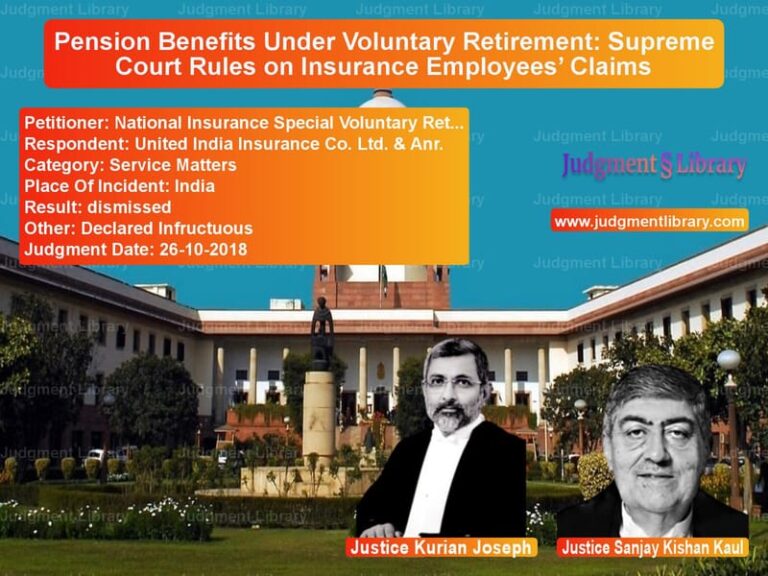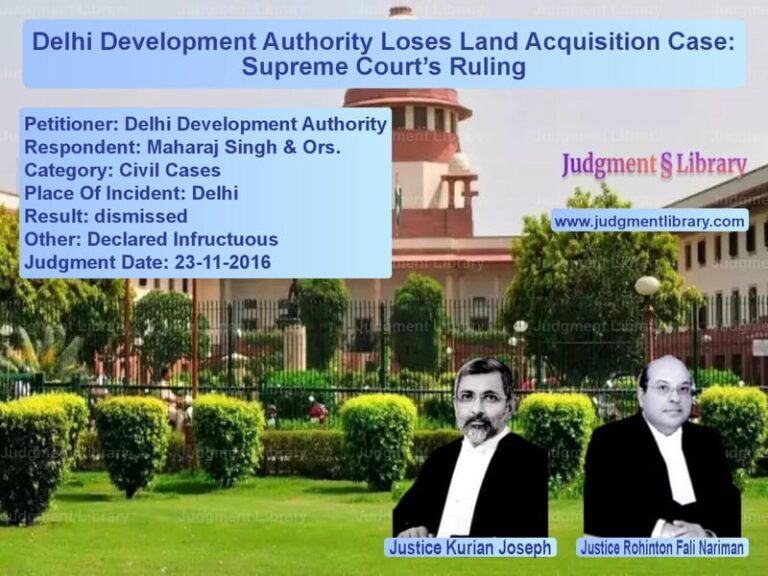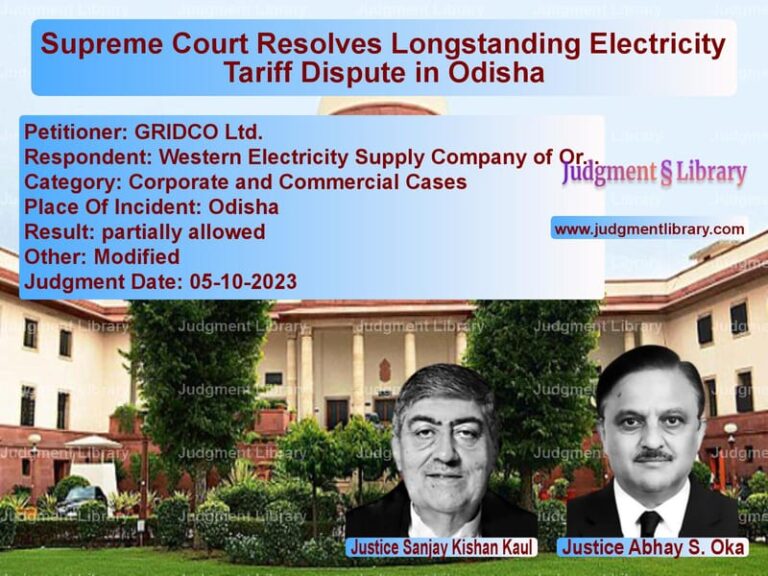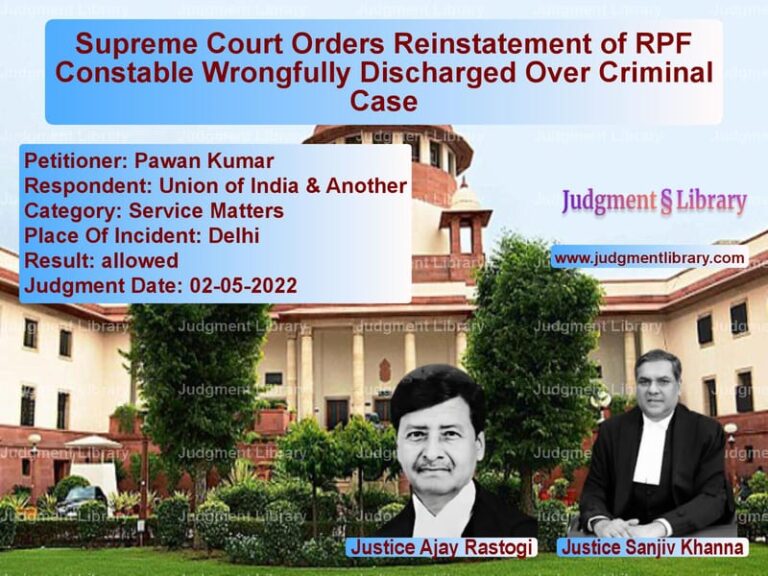Supreme Court Acquits Man in Culpable Homicide Case Due to Lack of Evidence
The case of Sekaran v. State of Tamil Nadu is a significant ruling by the Supreme Court on the evidentiary standards required to convict an accused in a culpable homicide case. The Court examined whether the prosecution had successfully proven beyond reasonable doubt that the accused was responsible for the death of the victim. The judgment ultimately acquitted the accused due to inconsistencies in the evidence and failure to establish intent.
Background of the Case
The case involved the alleged murder of Palas by the appellant, Sekaran. The prosecution claimed that on March 12, 1996, the victim, Palas, had an altercation with the appellant over unpaid wages at a tea stall. The appellant allegedly struck the victim on the head with a rubber stick, leading to his hospitalization. Palas was initially treated at a private nursing home but was later transferred to a government hospital, where he died on March 14, 1996.
An FIR was registered on March 15, 1996, at the Arumanai Police Station. The trial court convicted the appellant for murder under Section 302 IPC and sentenced him to life imprisonment. The Madras High Court, however, reduced the conviction to culpable homicide not amounting to murder (Section 304-Part II IPC) and sentenced him to five years of rigorous imprisonment. The appellant challenged this verdict before the Supreme Court.
Legal Issues Raised
- Was the prosecution able to establish beyond reasonable doubt that the accused was responsible for the death of the victim?
- Did the appellant have the intention to cause death or grievous harm?
- Was there sufficient medical and forensic evidence to link the appellant to the victim’s death?
Arguments of the Appellant
The appellant, represented by senior counsel, contended:
- The case against him was fabricated, and the FIR was registered after an undue delay of three days.
- Key prosecution witnesses were not examined, raising doubts about the reliability of the evidence.
- The medical records did not conclusively establish that the victim’s death was caused by injuries inflicted by the appellant.
- The rubber stick allegedly used in the assault was never recovered.
- The victim’s injuries were consistent with a fall from a tree, which was initially recorded as the cause of death.
Arguments of the Respondent (State of Tamil Nadu)
The prosecution, represented by the State, argued:
- The conviction was based on eyewitness testimony from PWs 2 and 3, who saw the appellant attack the victim.
- The victim sustained head injuries, which were confirmed as the cause of death in the post-mortem report.
- The delay in lodging the FIR was justified, as the priority was to provide medical care to the victim.
- The inconsistencies in medical reports were minor and did not undermine the overall case.
Supreme Court’s Observations
1. Delay in FIR Weakens the Prosecution’s Case
The Court noted that the FIR was lodged on March 15, 1996, three days after the incident. This delay raised serious doubts about the reliability of the prosecution’s version. The Court stated:
“In cases where there is an unexplained delay in lodging an FIR, the possibility of fabrication cannot be ruled out.”
2. Eyewitness Testimonies Were Unreliable
The Court found that key eyewitnesses, Ponnaian and Velukutti, were not examined by the prosecution. The testimony of PWs 2 and 3 was inconsistent, particularly regarding whether they reported the assault to the doctors treating the victim.
3. Medical Evidence Did Not Prove Homicide Beyond Doubt
The medical reports indicated that the victim suffered a head injury but also had multiple scratch injuries. The autopsy revealed the presence of ethyl alcohol in the victim’s blood, raising the possibility that he was intoxicated and fell from a tree, as initially recorded in the hospital documents.
The Court held:
“The failure to produce conclusive medical evidence linking the injuries to an assault by the appellant creates reasonable doubt.”
4. Absence of the Alleged Weapon
The prosecution failed to recover the rubber stick allegedly used in the assault. Without forensic evidence linking the appellant to the victim’s injuries, the Court found that the case relied solely on weak eyewitness accounts.
5. Benefit of Doubt Must Be Given to the Accused
The Supreme Court reiterated the principle that if two views are possible, the benefit of doubt must be given to the accused. The Court observed:
“The prosecution has failed to establish its case beyond reasonable doubt. The appellant is entitled to the benefit of doubt and acquittal.”
Final Judgment
The Supreme Court ruled:
- The conviction under Section 304-Part II IPC was set aside.
- The appellant was acquitted of all charges.
- The appellant was ordered to be released immediately unless required in any other case.
The Court concluded:
“The evidence on record does not conclusively establish the appellant’s guilt. The benefit of doubt must be extended, and the conviction is set aside.”
Key Takeaways
1. FIR Delay Can Be Fatal to the Prosecution
If an FIR is not lodged promptly and there is no satisfactory explanation for the delay, courts may infer that the case has been fabricated.
2. Medical Evidence Must Be Conclusive
In cases of culpable homicide, medical reports must directly link the accused’s actions to the victim’s death.
3. Eyewitness Testimonies Must Be Consistent
If prosecution witnesses provide conflicting statements, courts may disregard their testimony.
4. Benefit of Doubt Favors the Accused
When two interpretations of evidence are possible, courts must acquit the accused if there is reasonable doubt.
Conclusion
The Supreme Court’s ruling in this case underscores the importance of strong evidentiary support in criminal convictions. The decision reinforces the principle that convictions must be based on clear and compelling evidence rather than assumptions or weak testimony. This judgment serves as a precedent for future cases where circumstantial evidence and procedural lapses lead to wrongful convictions.
Read also: https://judgmentlibrary.com/supreme-court-upholds-high-courts-acquittal-in-27-year-old-murder-case/
Petitioner Name: Sekaran.Respondent Name: State of Tamil Nadu.Judgment By: Justice B.R. Gavai, Justice Dipankar Datta, Justice Aravind Kumar.Place Of Incident: Kanyakumari, Tamil Nadu.Judgment Date: 11-12-2023.
Don’t miss out on the full details! Download the complete judgment in PDF format below and gain valuable insights instantly!
Download Judgment: sekaran-vs-state-of-tamil-nadu-supreme-court-of-india-judgment-dated-11-12-2023.pdf
Directly Download Judgment: Directly download this Judgment
See all petitions in Murder Cases
See all petitions in Bail and Anticipatory Bail
See all petitions in Judgment by B R Gavai
See all petitions in Judgment by Dipankar Datta
See all petitions in Judgment by Aravind Kumar
See all petitions in allowed
See all petitions in Quashed
See all petitions in supreme court of India judgments December 2023
See all petitions in 2023 judgments
See all posts in Criminal Cases Category
See all allowed petitions in Criminal Cases Category
See all Dismissed petitions in Criminal Cases Category
See all partially allowed petitions in Criminal Cases Category







